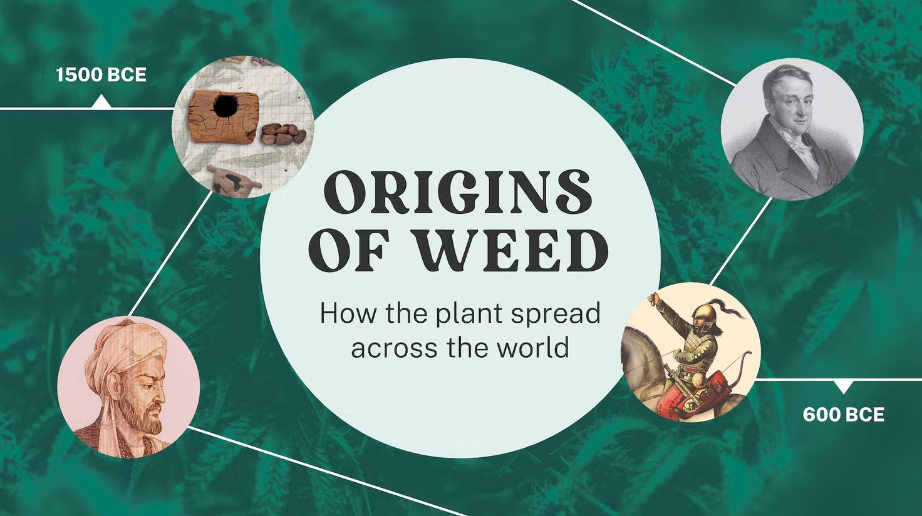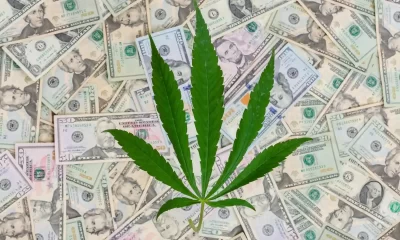Blogs
The origins of weed: How the plant spread across the world

Cannabis has grown and evolved with humans for thousands of years. Many separate cultures cultivated the plant, using its seeds for food, its fibers to make textiles, rope, and other materials, and its buds as a medicine and psychoactive substance in spiritual ceremonies. Cannabis proved to be a very useful plant for our ancestors and it continues to be today.
If there was one thing our ancestors knew, it was the healing properties of cannabis. While the wonders of cannabis medicine may feel like a new discovery in the West, cultures in the East have used and documented it for thousands of years.
Check out the story of cannabis—where it originated, how it spread across the globe, and which cultures used it. Learn how important the plant was to ancient humans and how it continues to be important to humans today.

Where did weed first grow wild?
Cannabis likely originated in Central Asia, in parts of China, Mongolia, Russia, Kazakhstan, Pakistan, and India. Humans began practicing agriculture about 10,000 years ago, and cannabis is believed to have been cultivated by humans 5,000 – 6,000 years ago. In prehistoric times, as weather warmed and humans migrated, they brought cannabis with them, spreading the plant far and wide.
From Central Asia, cannabis is believed to have spread to the Middle East and the east coast of Africa, as well as to Southeast Asia. It would eventually make its way to Europe and the Americas hundreds of years later.
Different types of cannabis started to develop in specific regions—these are called landraces today. These strains, such as Hindu Kush, from the Kush Mountains of Pakistan and Afghanistan, are native to a specific region and are influenced by that region’s climate, geography, soil, and environment.
Medicinal cannabis in ancient China
The world’s oldest text on medicine, the Pen-ts’ao Ching, first became prominent during the late Han Dynasty, in the second century CE, but was compiled from ancient texts. It refers to Emperor Shen-Nung, the father of Chinese medicine, who lived around at least 2000 BCE, who recognized the benefits of cannabis for over 100 ailments. The Pen-ts’ao Ching represents the earliest record of cannabis as a medicinal drug, emphasizing the plant’s healing potential, and how safe it was to use.
A concoction of female cannabis flowers is referred to as “ma-fen,” in the Pen ts’ao Ching. Chinese medicine is premised on yin and yang, and cannabis was viewed as a medicine that restored yin, useful for conditions such as gout, rheumatic pain, constipation, malaria, and gynecological disorders.
Note that “hemp” and “cannabis” are interchangeable in ancient texts. Today, we define “hemp” as cannabis plants with less than 0.3% delta-9 THC, but our ancestors did not make this distinction. Hemp fiber was used to create materials, its seeds for food, and its buds for medicinal or spiritual practices.
Linguistic analysts even tell us that medicinal cannabis influenced certain Chinese compound words, including the words for “numb,” “narcotic,” and “paralysis,” which are all formed with the word “má,” meaning “hemp,” and which can describe the effects of cannabis.
In 2019, scientists discovered a wooden brazier dating back to around 1500 BCE. Ten of these devices were found at a cemetary in the Eastern Pamir region of China, suggesting they were part of a burial ceremony. These braziers were pieces of wood with deep wells carved into them, and the charred residue inside contained traces of cannabinoids. Cannabis and a heated rock would be placed inside the braziers and the smoke inhaled.
Additionally, another use of cannabis pops up in China centuries after the time of the wooden braziers, in documents from the Han Dynasty (200 BCE – 220 CE). They describe the pain-relieving properties of cannabis based on the work of a renowned surgeon, Hua Tuo, who performed surgeries without inflicting pain on his patients due to his application of “máyóu,” an oil infused with cannabis resin, datura, and wine.
Cannabis in India: Sacred medicine and Ayurveda
Cannabis features prominently in the Atharva Veda, a collection of holy writings in Sanskrit dating back to at least 800 BCE, if not earlier. The text mentions cannabis as one of five sacred plants, its medicinal uses merged with religious and ritual practices. It was recognized as a source of happiness and a bringer of joy and freedom.
The plant was also described in the Susrita Samhita, a foundational text of Ayurvedic medicine from around 800 BCE, which explains the plant’s many healing properties. Cannabis was used for a staggering range of treatments: as an appetite stimulant, pain-reliever, anesthetic, anticonvulsant, and antiparasitic, among others.
Bhang, a drink made of cannabis, warm milk, nuts, and spices, was a common remedy for ailments and also thought to be a favorite food of the god Shiva. Bhang was considered highly effective at relieving anxiety and is still consumed in sacred contexts such as during the Holi festival.
Other medicinal and sacred preparations of cannabis include ganja, or smoking the female flowers, and charas, rolled balls of hash that are smoked. These forms of cannabis are still consumed in the present day, albeit under the radar.
Shemshemet in ancient Egypt
Historians tell us that cannabis found its way to Egypt from Central Asia, with medical records written on papyrus in 1550 BCE highlighting the plant’s anti-inflammatory properties and its use as an aid in childbirth. The Egyptians administered cannabis creatively—by the mouth and skin, but also by the rectum, vagina, and in the eyes.
Many scholars think a word found in many Egyptian hieroglyphs, “shemshemet,” refers to a plant used both for rope and medicine—likely hemp. Remains of the plant have also been found in the tombs of pharaohs, including Akhenaten, or Amenhotep IV, who lived around 1335 BCE, and Ramses II, who lived from 1303–1212 BCE.
The Scythians of Central Asia
The Scythians were an ancient nomadic people who lived around 600 BCE – 400 CE, in a large expanse of land in Central Asia, between the Black Sea and Siberia. Greek historian Herodotus observed a “Scythian vapor bath,” in which people would sit inside a tent and place cannabis and heated rocks in wooden braziers—perhaps the world’s first recorded hot box.
The “Siberian Ice Maiden” dates back to 500 BCE and is believed to have treated her breast cancer with cannabis.
Two gold bongs dating to around 600 BCE were also found in Central Asia and are thought to belong to the Scythians.
A mummified body of a woman was also found in the Altai Mountains of southern Siberia, dating back to around 500 BCE. Named the “Siberian Ice Maiden,” she was buried with a pouch of cannabis. An MRI scan in the present revealed she had breast cancer; scientists theorize that she might have used cannabis for her condition.
Cannabis in Greece and Rome
Greeks and Romans commonly used cannabis for rope and sails, and the earliest surviving account of medicinal cannabis among the Greeks is an entry in the De materia medica, written by the physician Dioscorides, around the first century CE. Dioscorides sings the plant’s praises as a treatment for earache and offers specific instructions of how cannabis medicine should be prepared as a juice from young, green cannabis seeds.
Dioscorides’ recognition of cannabis as a medicine was followed closely by Pliny the Elder’s entry in Naturalis Historia in 77 CE. Pliny discussed the medical use of cannabis for aching joints, gout, and burns.
Galen, physician to Roman Emperor Marcus Aurelius, who lived in the second century CE, warned of eating too many cakes containing hemp seeds, which were known to be popular at Roman banquets for their ability to create relaxation, hilarity, and euphoria. He said they also induced thirst, made one sluggish, and made it difficult to digest.
Hashish in the Arab and Persian worlds
Several hundred years later, in an area that was once part of the Roman Empire, Arabic scholars al-Mayusi (living around 1000 CE) and al-Badri (living in the 15th century CE) called attention to cannabis as an effective treatment for epilepsy. Additionally, Avicenna, a highly regarded Persian scholar who published his celebrated Canon of Medicine in 1025 CE, acknowledged cannabis as a useful treatment for pain relief, gout, edema, infectious wounds, and eye inflammation.
Persian scholars had a sophisticated understanding of marijuana and were aware of its biphasic effects at different doses—how a little bit of THC can create positive effects, but a lot can create different, possibly negative, effects.
Persian scholars were some of the first to note that a little bit of THC can create positive effects, but a lot can create different, possibly negative, effects.
Also, the first cannabis edible is thought to have originated in Morocco: mahjoun, a sweet treat filled with hash. A traditional version includes a paste of figs, dates, and hash, covered with nuts and other flavorings such as honey, rosewater, sea salt, turmeric, cardamom, ginger, cinnamon, and lavender.
Cannabis in Africa
The plant is widely believed to have been introduced to East Africa from India and the Middle East by Arabic traders, at least since the 1400s. Cannabis was known to be a part of the culture of enslaved Africans in Brazil, presumably brought over from Africa, especially the area of Angola today, in West Africa.
Weed in Europe
Cannabis may have arrived in Europe via the Scythians of Central Asia, with the plant possibly making its way from east to west via the “Bronze Road,” which would later become known as the Silk Road. Hemp has also been found in Germanic burials dating back to 500 BCE.
In the 8th-15th centuries CE, after cannabis had made its way to the Middle East from its origins in Central Asia, Arabic traders are thought to have spread the plant throughout North Africa and into Spain, which were parts of various Arab or Berber states.
The Anglo Saxon Old English Herbarium was one of the first texts to document cannabis usage in Europe, written in the 11th century CE. The Herbarium describes cannabis as an anesthetic and pain reliever, and was also used to help with gout, urinary infections, childbirth issues, and weight loss.
Cannabis is also mentioned in the 12th century medical texts of German Hildegard von Bingen, seer, scholar, physician, and abbess.
More records of cannabis occur in 1484, in a papal bull condemning the plant, issued by Pope Innocent VIII. However, several maritime republics are thought to have ignored it, as they relied on the plant’s fiber for making rope and sails. During the Italian Renaissance it was used for paper and canvas.
Hemp medicinal usage was also recorded in medical texts in England as early as the 1500s, during the reign of the Tudors.
Smoking cannabis for its psychoactive effects, in particular hashish, became popular in Europe after Napoleon’s 1798 campaign in Egypt, where French troops were encouraged to embrace hashish. Bringing the plant back home, cannabis use spread throughout Europe in the modern age, where it was used to treat a variety of ailments.
Weed spreads to the Americas
Cannabis hopped across the Atlantic Ocean to the Americas a few different ways. It was first thought to have crossed over via the Spanish, after their invasion of the Americas beginning in 1492.
Cannabis is believed to have first come to the Americas via the Spanish, during their invasions beginning in 1492.
Hemp is thought to have first shown up in North America in the early 1500s, when Hernán Cortés and his Spanish soldiers invaded Mexico. Soldier Pedro Cuadrado and a friend started a successful business growing hemp there. However, in 1550, a Spanish governor restricted production because the locals were getting high with the plant rather than using it for rope and textiles.
Further north in the 13 colonies, King James I of England enacted a royal decree in 1611 that instructed the colonists of Jamestown, Virginia, to grow hemp. Hemp was a valuable crop for many colonists, as it could be used to make rope, sails, clothes, textiles, and other materials.
As mentioned previously, cannabis is also thought to have come to South America, in particular Brazil, via enslaved Africans, around the 16th century. After the abolition of slavery in British colonies in 1834, it is thought that Indian indentured servants brought cannabis to the Caribbean. “Ganja,” a term originating in India, became especially popular in Jamaica, a British colony at the time, where it is still commonly consumed today.
Medical cannabis in the West in modern times
As interest in cannabis increased in the 19th century, the plant was brought to the attention of Western medicine in 1839, when Irish doctor William O’Shaughnessy published On the Preparations of the Indian Hemp, or Gunjah. He had worked in India and experimented with the plant and its uses there, noting its success as a treatment for rheumatism, convulsions, and spasms associated with tetanus and rabies.
In France, psychiatrist Jacques-Joseph Moreau experimented with hash, theorizing that it could help treat mental illness. Moreau wrote a book called Hashish and Mental Illness. The work of O’Shaughnessy and Moreau had a significant impact on Western medicine.
In the latter half of the 19th century, more than 100 studies were conducted on the plant, and pharmaceutical companies in the US and Europe began creating and marketing cannabis tinctures. Medicines containing cannabis became widely available to the general public, with many brands claiming to cure a variety of ailments.
In the late 19th and early 20th centuries, views of cannabis began to shift and many countries began outlawing the plant, most notably, the US.
To continue the story of cannabis and how it was criminalized, check out our History of cannabis prohibition.
Source: https://www.leafly.com/news/cannabis-101/origins-of-weed
Blogs
Border sales a boost for most marijuana retailers across US

Marijuana sales along state lines are key revenue generators for retail operators in the United States, and new insights suggest a similar business bump along international borders, particularly Mexico.
Data compiled by New York-based wholesale technology platform LeafLink – as well as information gathered from state agencies, quarterly reports and interviews with several cannabis companies – bear that out.
LeafLink analyzed hundreds of ZIP codes at the request of MJBizDaily and found strong links that when new recreational markets open, retailers near borders stock up on inventory significantly more than operators located elsewhere in a state.
Data from the past three years revealed wholesale marijuana products purchased by border stores jumped 140% after the launch of adult-use sales, while retailers located in more interior areas increased purchases by about 80%.
“The growth when a state launches adult-use sales at a border store in terms of purchasing activity is around double the growth of the remainder of the state,” LeafLink Strategy Analyst Ben Burstein told MJBizDaily.
Of course, numerous factors are at play – perhaps none more impactful than the marijuana policies of neighboring states.
That’s why Illinois retailers near Wisconsin, where marijuana possession is illegal, are still attracting Wisconsinites nearly four years after the launch of recreational sales.
There also are retail sales-tax implications, a big reason why St. Louis-areas operators are seeing an influx of shoppers from southern Illinois, where cannabis taxes are at least three times higher than in Missouri.
Meanwhile, border retail in New Mexico is boosting depressed economies along hundreds of miles of its shared borders, drawing stampedes of consumers from neighboring Texas and, more recently, cross-border buyers from Mexico.
Retail shakeup in the heartland
The February launch of adult-use sales in Missouri has caused ripple effects throughout the Midwest.
Missouri holds the rare distinction of bordering eight states, with only Illinois offering recreational marijuana sales.
Missouri’s 6% retail tax on recreational marijuana purchases is also among the lowest in the nation, drawing Illinois consumers across the Mississippi River in droves to buy much cheaper weed.
All in, cannabis sales taxes in neighboring Illinois eclipse 30%, second only to Washington state. And in Chicago, sales taxes can easily top 40%.
Demand is booming in western Missouri, too.
In April, Missouri retailers near the border of Kansas, where marijuana possession is also illegal, told MJBizDaily they were seeing foot traffic increase ninefold after expanding into recreational sales.
The rush of new customers, coupled with cultivation-capacity lags, has led to big spikes in wholesale flower prices and inventory shortages throughout the supply chain.
Retailers, for their part, are trying to keep pace.
To meet consumer demand, wholesale purchases per store in the Kansas City, Missouri, market increased from $97,000 in the quarter before the launch of recreational sales to $491,000 in the quarter after, a whopping 406% jump, according to LeafLink data.
In the St. Louis market, which borders southwestern Illinois, wholesale purchases per store increased nearly 57%, to $610,000, after adult-use sales began.
“The demand’s been bigger than anyone expected,” Burstein said.
A zero-sum game
In marijuana retail, particularly near state borders, it’s a zero-sum game.
The sales boom in the St. Louis market, which has more than 70 stores, has deflated business on the Illinois side of the border, where retailers have lost millions of dollars in sales since Missouri’s adult-use launch, according to quarterly reports and earnings calls.
Top executives at New York-based multistate operator Ascend Wellness Holdings, which has two shops near the Missouri border, cited revenue declines at its southern Illinois stores in recent earnings, saying it has led to suppressed margins that are expected to linger for much of the year.
Florida-based MSO Jushi Holdings, which also operates two Illinois stores near the Missouri border, reported an 8.8% year-over-year revenue decline to $66.4 million in its second quarter, partially attributing the slide to adult-use sales in Missouri.
In an Aug. 11 second-quarter earnings call, Jushi CEO James Cacioppo said total Illinois sales declined 20% from the first quarter and 40% year-over-year.
“I think we under-anticipated the pricing power initially out of the gate that retailers were going to have in Missouri,” Jushi Chief Strategy Director Trent Woloveck told MJBizDaily in an interview.
“The impact was a little bit greater than then we had thought due to that pricing for flower, vapes and infused products.”
In response, Jushi has implemented several initiatives, including adding new promotions and diversifying product SKUs (stock-keeping units) to ease the impact of declines sales in Illinois.
Northern exposure
Market dynamics in northern Illinois, particularly along the Wisconsin border, are a different story.
Wisconsin is among 10 states without a medical or recreational marijuana program.
Illinois counties bordering Wisconsin – including Lake, McHenry, Jo Daviess and Winnebago – accounted for 15.4%, or $239.7 million, of the nearly $1.6 billion in cannabis sales last year in the state, according to a fiscal analysis requested by pro marijuana-legalization lawmakers in Wisconsin.
The Wisconsin Legislative Fiscal Bureau report, which was released in March, cited annual statistics from the Illinois Department of Financial and Professional Regulation.
Moreover, the report estimated about 7.8% of marijuana sales in Illinois in 2022, roughly $36.1 million, were generated by out-of-state residents traveling from Wisconsin.
Under Illinois law, out-of-state residents can only purchase recreational cannabis.
Two of Chicago-based multistate operator Cresco Labs’ 10 stores in Illinois are located near the Wisconsin border: a Sunnyside outlet in South Beloit at the border and one in Rockford, about a 30-minute drive away.
The South Beloit store often draws up to 1,000 daily visitors, according to Cresco’s national retail president, Cory Rothschild – traffic on par with the nation’s busiest marijuana retailers in highly populated areas.
It’s all the more impressive, considering that South Beloit has a population of roughly 8,000 and is more than 40 miles from Madison, the nearest city and Wisconsin’s state capital.
“It’s an extremely high-volume retail location,” Rothschild told MJBizDaily.
“South Beloit and Rockford as well are probably (among the) top dispensaries in the country.”
Maryland
Maryland is the newest recreational cannabis market, with nearly 100 medical marijuana dispensaries having converted to adult-use retail in late June.
While LeafLink wholesale data suggests about a 10% increase in wholesale product purchases statewide after the launch of adult-use sales, some retailers along Maryland’s south and eastern borders are doubling orders to meet demand.
In Elkton, near the Delaware border, stores are ordering about $41,000 in wholesale products per month, up 115% since the launch of recreational sales on July 1.
In the Rockville/Germantown area – outside of Washington DC and near the Virginia and West Virginia borders – monthly wholesale purchases have increased about 42%, to $54,000 per store, since recreational sales began.
Though MMJ dispensaries opened in West Virginia in 2021, the state still has some of the harshest marijuana laws in the country, according to the Marijuana Policy Project.
Meanwhile, Virginia’s adult-use rollout has been put on ice by Republican Gov. Glenn Youngkin.
MSO MariMed’s wholesale business serving retailers in Maryland has benefited from increased demand from neighboring states, according to Jeff Jones, director of operations.
“We have retail customers that are very close to Virginia, Pennsylvania and West Virginia, and I’m sure that’s driving a significant amount of their business,” he said.
The Massachusetts-based company supplies every retailer in the state with its product brands.
MariMed is planning to double its cultivation and canopy space in Maryland, with product from that expansion expected to hit the wholesale and retail markets in the first quarter of 2024, Jones said.
Its retail operation in Annapolis – the state capital is about a 45-minute drive from Pennsylvania or West Virginia – hasn’t experienced the same type of uptick from border business but is still performing well, according to Jones.
A tale of two borders
The small town of Sunland Park, New Mexico, has racked up outsized sales since the state launched recreational retail in April 2022.
The sparsely populated bedroom community is situated across the border from El Paso, Texas, and Jaurez, Mexico, which have a combined population of more than 2.2 million.
That purchasing power has helped Sunland Park’s 88063 ZIP code top the state for per-capita adult-use spending, a sales metric that divides dollars spent for cannabis by population.
Per-person recreational marijuana spending in Sunland Park was $1,044, according to an MJBizDaily analysis of data from the New Mexico Regulation and Licensing Department.
Its 88063 ZIP code also houses two of New Mexico’s leading cannabis stores.
Ultra Health and Everest Cannabis Co. generated nearly $6.1 million in combined sales from August 2022 to February 2023, according to MJBizDaily research.
Because business has been so strong at that Sunland Park store, Ultra Health last summer opened an adjacent location that handles only online orders for pickups.
The majority of its 42 stores were strategically aligned to capture business along New Mexico’s more than 600-mile border with Texas, the second-most-populated state.
“I would say half our business is Texas-related,” Ultra Health CEO Duke Rodriguez told MJBizDaily.
As part of that strategy, the company is planning to open an outlet in Lordsburg with hopes of drawing customers from Mexico, Texas and Arizona.
Mexico border towns share more than commerce, including family, culture and language.
Some residents own commercial properties and homes on either side of the border.
And residents tend to travel freely between Juarez, El Paso and Sunland Park to shop, dine and visit friends and family, according to Rodriguez.
Many also buy regulated marijuana, which might come as a surprise to some industry watchers, especially those unfamiliar with border business in the Southwest.
Though transporting licensed cannabis across the U.S.-Mexico border is barred under federal law, it’s fairly common, industry insiders tell MJBizDaily.
“The product is intended to be consumed within the state of New Mexico and should not cross state or international boundaries,” Ultra Health’s Rodriguez advised.
“The reality is some consumers cross these boundaries intentionally or by not being fully aware of the risk and prohibition.”
Sales in other border communities, such as Clovis and Hobbs – where Ultra Health also has stores – are also outpacing the field, another sign that Texans, and some Mexicans, are crossing the border to purchase marijuana from New Mexico marijuana retailers.
Source: https://mjbizdaily.com/border-sales-a-boost-for-most-cannabis-retailers-across-us/
Blogs
Cannabis Art Is Flourishing On Etsy

Although there is an available and thriving market for cannabis art, most e-commerce websites and platforms prohibit artists from selling art that depicts cannabis.
Is there any section or industry without cannabis influence? It’s starting to look like there isn’t any, as, throughout history, cannabis users have displayed their creative capabilities in various ways. And now cannabis art is flourishing on Etsy
Cannabis users and enthusiasts are some of the most innovative people you’ll ever meet, and their inspiring works of art have been admired for decades. Most of the works created by cannabis enthusiasts have also sparked debate for centuries, dating William Shakespeare’s times.
Cannabis and the creative arts
Research has shown a fantastic connection between cannabis and creativity, an intriguing relationship that is attributed to the plant’s remarkable properties. Cannabis interacts with the human brain through the endocannabinoid system and receptors in the brain.
Extensive works of research show that creative prowess and imagination heighten when users consume cannabis, thus enabling divergent and distinct thought patterns. Hence the reason great men and women like Maya Angelou and Louis Armstrong celebrated the impact of cannabis on their creative careers.A more significant percentage of the creative industry is also full of trailblazers who have affirmed that cannabis is a significant influence on their success. For such artists, marijuana inspires the way they hone their crafts and showcase their ideas.
Despite such a show of artistic brilliance, some artists struggle with finding a place to showcase their works. Why is this the case? Why can’t artist showcase their cannabis-inspired art?
The problem with finding a market showcase
Although there is an available and thriving market for cannabis art, most e-commerce websites and platforms prohibit artists from selling art that depicts cannabis. Some of these merchant shops also flag items such as CBD paraphernalia and insist that such things cannot be sold.
With such restrictions, creative artists fail to get an adequate space to share their creations with the world. Artists feel shut out of the market space, and then COVID-19 happened.
The Coronavirus Pandemic made everything worse for cannabis artists and businesses to maintain operations, which created a disturbing gap in the market.
The Solution: A cannabis-themed marketplace
As the challenge became increasingly worse, two outspoken cannabis advocates co-founded an online marketplace called The Artsy Leaf. Space was set-up as a multi-vendor marketplace to make it possible for artists to display their works.
The co-founders Abbey Weintraub Sklar and Rebecca Goldberg discovered that there were many international craftsmen, women, and artists with products that weren’t shared on any platform. The artists’ products are unique cannabis-friendly items that were mostly scattered on censored tech platforms that limited their exposure to the world.
Goldberg and Skylar understood the importance of an online vendor marketplace created for creators and buyers in the cannabis industry. COVID-19 and its resultant impact was also the inspiration behind an online space.
Initially, it was supposed to be an in-person CBD marketplace, but the pandemic made physical meetings impossible for buying and selling purposes. Hence the reason the co-founders made it an online space with a highly functional website.
The Artsy Leaf
The Artsy Leaf marketplace replaces other online platforms that were too restrictive for those in the cannabis industry. Some of those unfriendly sites didn’t provide room for tagging, describing, and listing CBD products, making it difficult for artists to advertise their products.
But with the Artsy Leaf marketplace, vendors and small business owners have maximum freedom to advertise their cannabis items. The platform also incorporates advertising with SEO consulting and doesn’t hide its processing fees.
The co-founders maintain that their desire to help all cannabis vendors succeed drives the marketplace. The website launched with an initial 14 vendors, and with its viable operational approach, more vendors are expected to join this revolutionary idea.
A virtual cannabis marketplace is what the world needs right now to bridge the gap between artists and buyers. Cannabis-inspired pieces will always remain relevant globally because of how unique and disruptive they can be. The Artsy Leaf is the right incubation place for ideas, purchases, and value exchange.
The future of the online marketplace
The future of the online cannabis marketplace for artists looks promising, and why is this so important? Well, cannabis is gaining a lot of momentum in America, with more states legalizing marijuana more people will gain access to weed, and when they do, they may be inspired to create unique art pieces or be looking to purchase unique cannabis inspired works.
Either way, the cannabis world needs an outlet for artists to share their works, and this is where platforms like the Artsy Leaf become crucial. Other online platforms may start to look into adjusting their policies regarding this issue because this sector is about to explode.
It is time to change the current status quo on the other E-commerce sites not allowing cannabis artists to showcase their genius.
Bottom line
The world is awakening to the ever-increasing potentials of cannabis. Through marketplaces like the Artsy Leaf, cannabis artists and art lovers can meet, interact and sustain the cannabis industry.
Without platforms like these, cannabis-inspired art will gradually decline, and that isn’t good for the cannabis industry at all. We must all continue to encourage the establishments of platforms (online and offline) where artists can thrive. Budding cannabis artists need more places to express themselves, and the Artsy Leaf is a suitable platform.
If you are a cannabis-themed artist, an aspiring one, or a small business owner and you struggle with promoting your work, you can visit The Artsy Leaf.
Source: https://thefreshtoast.com/cannabusiness/cannabis-art-is-flourishing-on-etsy/
Blogs
Beer Lingo, A Guide To Becoming A Better Patron

Bars are wondrous places full of beer, chatter, celebration, ways to get drunk and opportunities to meet friends. But they are also tricky. As with most niche scenes, there is lingo you need to know, terms you should memorize and slang with which you should show facility. What’s Imperial mean? How do you pronounce “weisse?” And how much should I tip my bartender? Hang on, because you’re about to find out the answers to all of these. Here is your beer lingo, a guide to becoming a better patron. BTW, the Slavic word ‘beer’ came from the verb ‘to drink’. Initially, beer was any kind of drink.
Hops
https://giphy.com/embed/3oEduIpVOVcupPXcFG
via GIPHY
Small green pine cone-like buds that grow on vines. Their oils and acids preserve and flavor beer.
Hoppy
The thing snobby people refer to about beer, and what people who hardly ever drink beer say they don’t like. Hoppy is often used as a synonym for the word ‘bitter,’ but there are plenty of beers that use loads of hops and don’t taste the least bit bitter.
Malt
https://giphy.com/embed/3orieWw0snNJFCNxNC
via GIPHY
The sugars used to sweeten beer.
Malty
https://giphy.com/embed/2yxsvbwxQ4TUk
via GIPHY
That syrupy, sweet flavor in beer drunk by amateurs.
Perry
https://giphy.com/embed/d4bm8acp2cuHpLFK
via GIPHY
A cider-like drink made exclusively with pears.
Imperial
https://giphy.com/embed/3o7TKGVVeQK1j0fbe8
via GIPHY
A word out in front of certain beer styles (Stout, IPA) meaning they’re much stronger.
Mead
https://giphy.com/embed/yIXVnzpoNiE0w
via GIPHY
Beer produced from honey, water and yeast.
Ale
https://giphy.com/embed/lAayRqqtfuqju
via GIPHY
Ale is brewed using a warm fermentation method, resulting in a sweet, full-bodied and fruity taste. It is a maltier, top-fermented beer.
Lager
https://giphy.com/embed/dM34XK49ulmDu
via GIPHY
A beer that is effervescent and light in color and body. it is a dry, bottom-fermented drink.
IPA
Stands for India Pale Ale because it was originally brewed in the United Kingdom and shipped to British soldiers in India during colonization (which is still basically happening). It is made with more hops, to give it a stronger flavor. There’s no standardised threshold at which a pale ale becomes an IPA, though.
Cask-Conditioned
https://giphy.com/embed/dg3i5NvtNCr8A
via GIPHY
The process in which a draught beer retains yeast to enable a secondary fermentation to take place in a cask in the pub cellar. Cask conditioned beer is the traditional drink of the British pub, and served properly, it can be among the most subtle and beguiling of beer types.
Fresh Hop
https://giphy.com/embed/3oEdv8lx4icZfRYEPS
via GIPHY
Beer made with recently picked hops that haven’t been dried. It provides distinctively grassy, plant-like, and “green” flavor profiles without the bitterness associated with IPAs and other beers featuring copious dried hops.
Weisse
https://giphy.com/embed/qgqaIJrAgqawE
via GIPHY
Pronounced ‘Vice’ is the counterpart in German for “white,” most commonly used in reference to the sour Berliner type of beer, but also sometimes to the Bavarian type, as in weissbier. Weizen is the German word for “wheat,” most often applied to the Bavarian wheat beer style.
Microbrew
https://giphy.com/embed/l0MYtSjYO26kguz1C
via GIPHY
Compared to macrobreweries, which produce millions of barrels per year, microbreweries produce a relatively small amount of beer—between 1,000 to no more than 15,000 barrels annually. But aside from their size, what makes microbreweries special is that they’re known for brewing specialty beers.
The type of beer you do not use for beer pong unless you make more money than your bartender.
Pint
https://giphy.com/embed/DGWAx8d3IkICs
via GIPHY
The size of glass most beers are served in, and also the thing you dropped and smashed when you were trying to text your Uber driver.
Dive Bar
The kind of bar you actually really like going to, unless you’re trying to impress a date or a friend. It is typically a small, unglamorous, eclectic, old-style drinking establishment with inexpensive yet strong drinks; it may feature dim lighting, shabby or dated decor, neon beer signs, packaged beer sales, cash-only service, and local clientele
BTW, the strongest beer in the world has a strength of 67.5%. It was created in 2017 by the Scottish brewery Brewmeister. The beer is called Snake Venom
Pickup Line
https://giphy.com/embed/EU1obAC38GuWI
via GIPHY
The thing you should never say because it never works.
Tip
https://giphy.com/embed/kfGijLoNvBQ08
via GIPHY
The amount of money you give a bartender after a transaction, which should be more than you initially think to give because A) most bartenders are relatively poor and deserve dough, and B) if you tip a lot you’ll be remembered C) if you tip too little you’ll be remembered D )
How do you want to be remembered?
Patron
https://giphy.com/embed/3oz8xTawWVM7Npb1FS
via GIPHY
Someone who loves the bar they go to, not just someone who is there a lot. If you’re unclear on the distinction, you’ve never loved before.
Bar Napkin
https://giphy.com/embed/xT5LMO10TEI5k1gQAE
via GIPHY
Where much great poetry started.
The Bar
https://giphy.com/embed/PvZ2jLjFofH4Q
via GIPHY
Don’t touch anything behind it.
Hope you enjoyed our beer lingo, a guide to becoming a better patron.
Source: https://thefreshtoast.com/drink/beer-vocab-101-guide-becoming-better-patron/
-

 Business2 years ago
Business2 years agoPot Odor Does Not Justify Probable Cause for Vehicle Searches, Minnesota Court Affirms
-

 Business2 years ago
Business2 years agoNew Mexico cannabis operator fined, loses license for alleged BioTrack fraud
-

 Business2 years ago
Business2 years agoAlabama to make another attempt Dec. 1 to award medical cannabis licenses
-

 Business2 years ago
Business2 years agoWashington State Pays Out $9.4 Million in Refunds Relating to Drug Convictions
-

 Business2 years ago
Business2 years agoMarijuana companies suing US attorney general in federal prohibition challenge
-

 Business2 years ago
Business2 years agoLegal Marijuana Handed A Nothing Burger From NY State
-

 Business2 years ago
Business2 years agoCan Cannabis Help Seasonal Depression
-

 Blogs2 years ago
Blogs2 years agoCannabis Art Is Flourishing On Etsy









